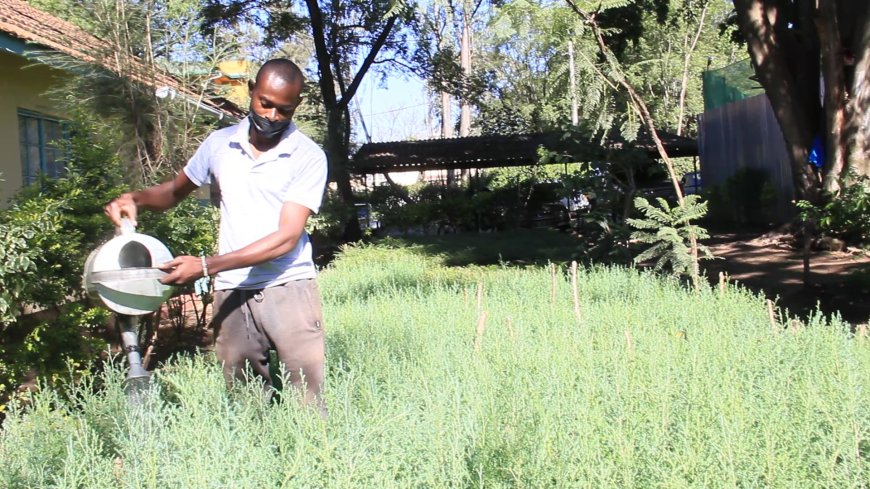Nakuru County Government gives youth a voice in climate change decision-making

Nakuru,
Thursday, 30 March 2023
K.N.A
By Anne Mwale
Nakuru County Government is involving the youth in key decisions pertaining to the environment to curb the perils of climate change.
In light of climate change and unpredictability of weather, the devolved unit has also unveiled various programmes designed to improve food security through promotion of climate smart agricultural technologies and nature-positive agricultural ways, particularly by investing more on indigenous, drought resistant crops.
According to the County Executive Committee Member (CECM) in charge of Water, Environment, Energy, Natural Resources and Climate Change Dr. Nelson Maara, policy makers need to give the youth more opportunities to address challenges posed by climate change and contribute to the sustainability of nature and protection of future generations.
“Although African youth voices on climate change are being heard in multilateral processes, active youth participation in real decision making is still lacking. There's a need for more meaningful inclusion of African youth voices across the board,” said Dr. Maara.
He reminded youths that their biggest role in environmental protection is raising awareness.
“The youth are no longer the future but actors of today. That is why we are now involving them in various environmental conservation aspects,” he added.
Dr. Maara observed that the youth comprise over 40 per cent of the global population, and their engagement remained a high priority in the multilateral system.
He spoke at his office in Nakuru after the County Climate Change Planning Committee presented the Participatory Climate Risk Assessment (PCRA) preparedness report to a delegation from the National Treasury- Financing Locally-Led Climate Action programme (FLLoCCA).
Also present were Chief Officer for Environment, Energy, Climate Change, and Natural Resources Chief Officer Mr. Kennedy Mungai, FLLoCCA Programme Manager Mr. Malik Aman and heads and representatives from the county directorates including Public health, Agriculture, Gender, Social Services Lands, Housing, and Urban Planning.
Dr. Maara stated that the current County Integrated Development Plan (CIDP) and a number of policies were seeking to mainstream climate change into planning and implementation.
He observed that the Climate Change Act (2016) mandates counties to implement and monitor ambitious sustainable development and climate change goals.
Climate change manifests itself primarily through erratic changes in the water cycle. Droughts, floods, rise in sea levels and storms intensify and become unpredictable, often with severe consequences.
Dr. Maara added “The concurrent problems of hunger, ill-health linked to diet, food insecurity, threats from new diseases and antimicrobial resistance, are rising among people living in poverty. These problems have been made worse in recent times by the Covid-19 pandemic. This is why the Nakuru County Government has put in place measures to cushion farmers and cater for food security interests.”
A recent study has revealed that in Kenya, temperatures have increased by 1.2 degrees Celsius since the 1960s, and that the warming has accelerated significantly in the past three decades.
The increase in temperature has had a substantial impact on the ecosystem, leading to reduced accessibility to water, decreased crop yields, and an upsurge in the occurrence and intensity of extreme weather events.
Mungai said the devolved unit was, through public-private partnerships, building capacity of communities to adopt environmentally friendly and resilient farming practices to mitigate against adverse effects of climate change.
"We want to sensitize mostly the young and learning population who are passionate about climate action to come out strongly and exploit their interest in this noble cause. The capacity building also targets the sensitization of the community on the health and economic value tied to climate mitigation through activities such as fruit-tree growing which not only provides a source of income but also enhances food security,” the Chief Officer stated.
He called for adoption of practices which will enhance natural soil fertility, moisture retention, seeds saving and more biodiversity and ecosystem services among others.
Such practices include farmers saving and exchanging seeds, soil health measures such as use of animal manure and vermin-culture, moisture retention through mulching and agroforestry among others.
He asked policy makers to break down environmental jargon so citizens in the grassroots could comprehend the global climate crisis and participate in protecting the environment.
“We need to tell climate stories in a simple language so we include everyone,” he said.
The Chief Officer added that indigenous people, local communities, young people, women and girls should be leaders of climate action and not victims of climate change.
Mungai indicated that about 80 per cent of Kenya’s population is below 35 years, making the voice of the youth important in this discourse.
The Chief Officer noted; “Involving the youth in this climate discourse will be a win-win situation for all since they have been leading the way in coming up with innovative ideas and measures to curb carbon emissions.”
He went on; “The development and review of climate change action plans should therefore involve all youths, including youth organization representatives, young green campaigners, innovators and entrepreneurs with the best innovative ideas on best practices and information towards achieving environmental sustainability in the country.”
Kenya has indoctrinated the protection of its environment in both international environmental treaties and national laws, including the Constitution of Kenya 2010, Acts of Parliament – including the Climate Change Act of 2016, Regulations of the same Acts and laws passed by some of the 47 county assemblies.
Despite all these excellent laws that should have put Kenya on its way into a green pathway, the country is still experiencing adverse effects of the climate crisis, including regular droughts and floods which affect about two million people every year.
According to the World Health Organization, environmental hazards take the lives of 13 million people every year.
Aman said the PCRA process will ensure that climate change interventions are sustainable and relevant to the community.
Courtesy K.N.A
What's Your Reaction?



































































































































































































































































































